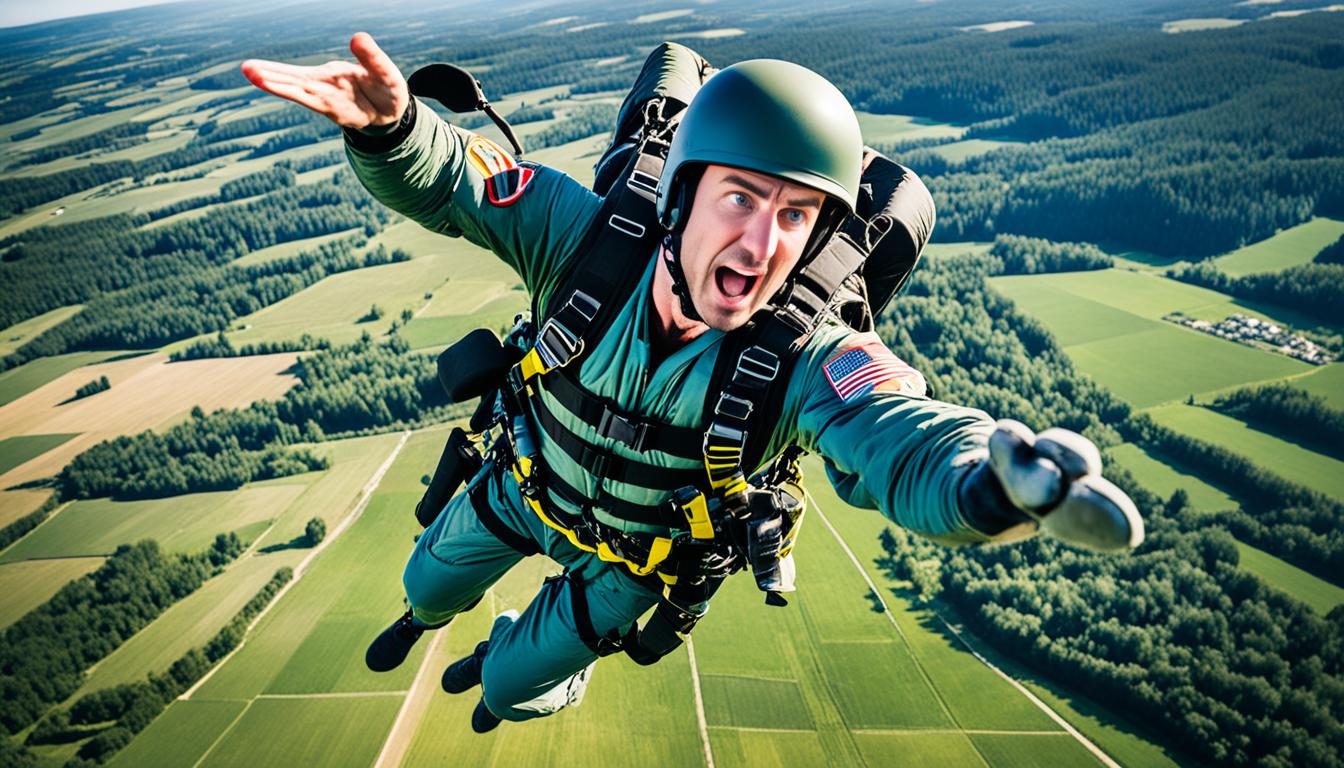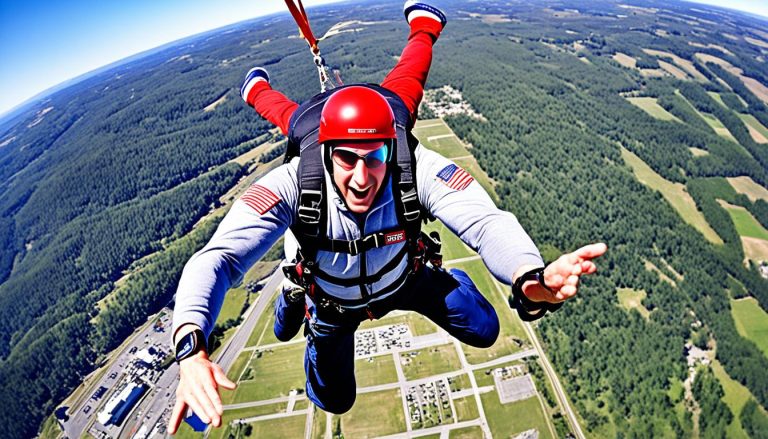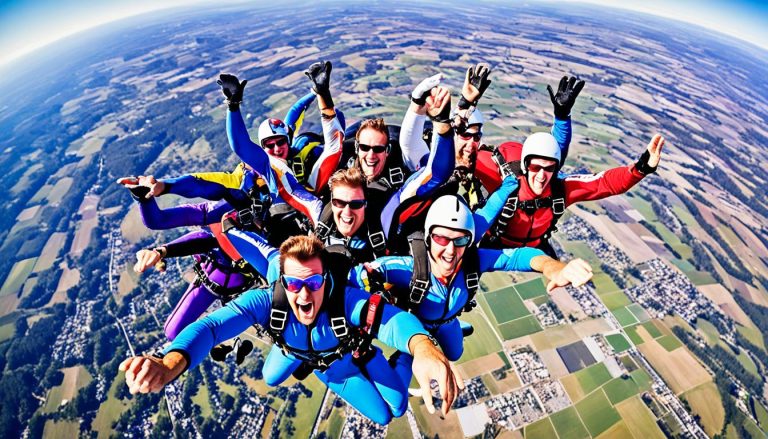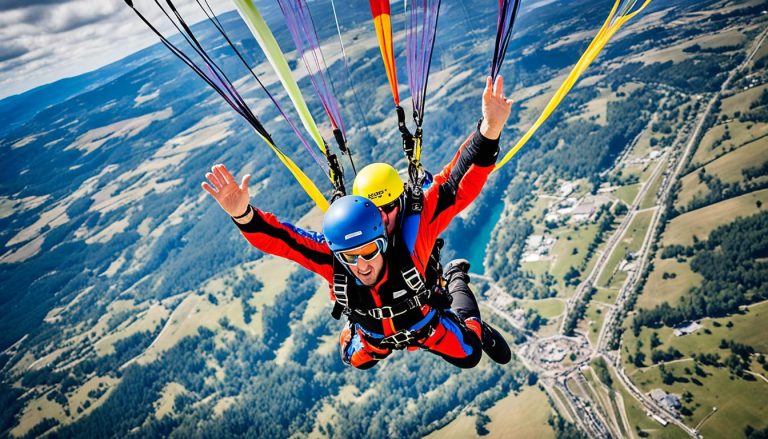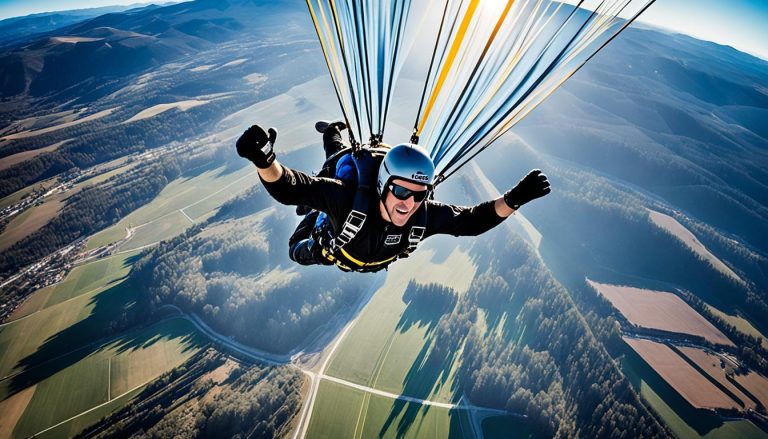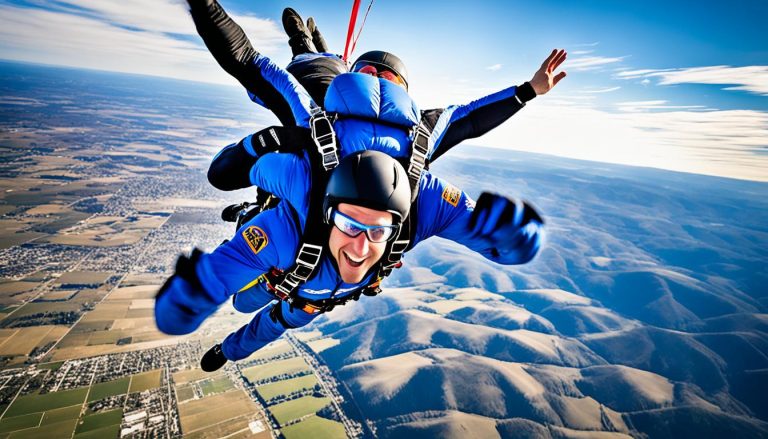Emergency Protocols: What to do when things don’t go as planned during Parachuting
When it comes to the thrilling sport of parachuting, skydivers must always prioritize safety and be prepared for any unforeseen circumstances that may arise. This includes being familiar with emergency procedures, adhering to strict safety protocols, and knowing how to deal with parachute malfunctions.
In this article, we will explore the essential emergency protocols that every skydiver should be well-versed in. From understanding proper parachute deployment techniques to handling potential equipment failures, we will delve into the necessary steps to handle emergency situations with confidence.
Whether it’s a total parachute malfunction or an unexpected equipment failure, skydivers must have a mindset of readiness and be equipped with the necessary knowledge and skills to navigate these challenges effectively. By adhering to established protocols and maintaining a proactive approach to safety, skydivers can enjoy the thrill of the sport while ensuring their well-being is never compromised.
Skydiving Emergencies and Preventative Measures
Regularly reviewing and practicing emergency procedures is crucial for skydivers to respond effectively to problems that may arise during a jump. By familiarizing themselves with these procedures and implementing preventative measures, skydivers can significantly reduce the probability of encountering an emergency situation.
One important aspect of preparedness is conducting an annual review of emergency procedures. This ensures that skydivers are up-to-date with the latest protocols and techniques. Additionally, practicing these procedures during reserve repacks on the ground helps maintain muscle memory and reinforces the correct responses.
Responsible judgment plays a vital role in preventing emergencies. Skydivers should acquire accurate knowledge and make informed decisions about when and where to jump. Evaluating risk factors, such as weather conditions and equipment conditions, is essential. Skydivers should only jump in suitable conditions and avoid situations that may pose unnecessary risks.
Knowing one’s personal limitations is crucial for ensuring a safe skydiving experience. Skydivers should understand their capabilities and skill level and not push beyond them. By being aware of these limitations, skydivers can minimize the chances of encountering situations that exceed their abilities.
Keeping options open is another important aspect of preventative measures. Skydivers should always be prepared to make decisions based on changing circumstances during a jump. This includes maintaining situational awareness and having contingency plans in place. By being flexible and adaptable, skydivers can respond effectively to unexpected situations.
In the event of an actual emergency, prompt action is vital. Skydivers should be prepared to deploy their parachute at the correct altitude and follow the appropriate emergency procedures. Landing in a clear area, away from potential hazards, is essential for ensuring a safe landing.
Parachuting Emergency Procedures
| Emergency Situation | Procedure |
|---|---|
| Total Parachute Failure | Deploy Reserve Parachute |
| Partial Parachute Malfunction | Deploy Reserve Parachute |
| Pilot Chute in Tow Malfunction | Pull Reserve Immediately or Cut Away and Deploy Reserve |
| Brake-Line Break | Follow Predetermined Procedure to Maintain Control |
| Spinning Malfunction | Follow Predetermined Procedure to Maintain Control |
By prioritizing emergency procedures and proactive prevention measures, skydivers can enjoy the exhilaration of the sport while minimizing potential dangers. It is crucial for skydivers to stay vigilant, practice regularly, and maintain a mindset of safety at all times.
Parachute Malfunctions and Procedures
During a skydiving experience, parachute malfunctions can occur due to various reasons, such as a poor body position during deployment, faulty equipment, or improper packing. Skydivers must be well-versed in specific procedures for dealing with different types of malfunctions to ensure their safety and the success of their jump.
There are two main categories of parachute malfunctions: total malfunctions and partial malfunctions. In a total malfunction, the main parachute fails to deploy or deploys improperly, putting the skydiver at risk. On the other hand, a partial malfunction occurs when the canopy partially deploys but becomes unlandable.
When faced with a total malfunction, it is essential for skydivers to take immediate action at the predetermined altitude. Deploying the reserve parachute is the primary procedure to follow, ensuring a safe descent and landing. This is a critical situation where quick thinking and proper execution are paramount.
In the case of a partial malfunction, skydivers must assess the situation carefully to determine the best course of action. Sometimes, attempting to fix the malfunction can worsen the situation and increase the risk. In such cases, deploying the reserve parachute becomes necessary for a safe landing.
Another common malfunction in skydiving is the pilot chute in tow. This occurs when the main parachute fails to dislodge from the container due to the entanglement of the pilot chute. Skydivers have two common procedures to choose from: pulling the reserve handle immediately, which is the most straightforward approach, or cutting away the main parachute and then deploying the reserve. Choosing the appropriate procedure depends on the skydiver’s training and evaluation of the specific situation.
Common Parachute Malfunctions and Procedures
| Parachute Malfunction | Procedure |
|---|---|
| Total Malfunction | Deploy the reserve parachute |
| Partial Malfunction | Assess the situation and deploy the reserve parachute if necessary |
| Pilot Chute in Tow | Option 1: Pull the reserve handle immediately Option 2: Cut away the main parachute and deploy the reserve |
Skydivers should also be aware of the potential risks associated with premature main container opening and out-of-sequence pilot-chute extraction. These malfunctions can be prevented through proper packing techniques and regular equipment inspections.
Importance of Practicing Emergency Procedures and Knowing Your Canopy
Regularly practicing emergency procedures under an open canopy is essential for skydivers to maintain proficiency and be prepared for unexpected situations. It not only improves their response time but also increases their ability to handle emergencies with confidence.
One of the key aspects of practicing emergency procedures is familiarizing oneself with the position of handles. Skydivers should know the exact location of important handles such as the main canopy release, reserve parachute, and cutaway handles. This knowledge ensures swift and accurate action during critical moments.
Simulating emergency scenarios during training sessions helps skydivers develop muscle memory and quick decision-making skills. By practicing emergency drills repeatedly, they can develop the ability to react instinctively and effectively when faced with actual emergencies.
A crucial aspect of skydiving safety is understanding the performance characteristics of one’s canopy. Skydivers should be aware of how their canopy behaves in different situations, such as turns and line twists. This knowledge allows them to make appropriate adjustments and maintain control during challenging circumstances.
“Knowing your canopy is like knowing a reliable partner. It allows you to predict its behavior and respond accordingly,” says Jane Johnson, an experienced skydiving instructor.
Investing in canopy coaching can provide skydivers with valuable insights and guidance. Professional coaches can help them fine-tune their canopy control skills, identify areas for improvement, and enhance their overall safety. This personalized training contributes to a deeper understanding of canopy behavior and fosters a greater sense of confidence.
To summarize, regularly practicing emergency procedures and understanding the intricacies of one’s canopy are fundamental to parachute safety. Skydivers who are well-prepared and knowledgeable about their equipment are better equipped to handle unexpected situations and respond to emergencies efficiently. By prioritizing training and seeking professional guidance, skydivers can enhance their risk management skills and ensure a safer and more enjoyable experience in the skies.
The Importance of Simple Procedures and Concentration
While skydiving procedures may seem simple, it is important for skydivers to maintain concentration and follow them diligently. This includes conducting gear checks before boarding the plane, ensuring proper equipment maintenance, and staying alert during each jump. Simple procedures, such as checking handles and exercising common sense, play a crucial role in mitigating risks and preventing emergencies. Skydivers should also be mindful of the potential distractions that can arise during a jump and maintain focus on the task at hand.
The Role of Parachuting Safety Protocols
Skydiving safety protocols are designed to ensure the well-being of skydivers and minimize the possibility of accidents or emergencies. By adhering to these protocols, skydivers can create a safer environment for themselves and others. This includes conducting thorough gear checks before each jump, ensuring that all equipment is in proper working condition, and following established guidelines for equipment use and maintenance. Skydivers should also stay up to date with the latest safety protocols and be proactive in implementing them.
Parachuting Equipment Maintenance
Proper maintenance of parachuting equipment is vital for ensuring its reliability and effectiveness. Regular inspections, cleaning, and maintenance of parachutes, harnesses, and other gear are essential to identify and address any potential issues before they become safety hazards. This includes checking for any signs of wear or damage, properly packing the parachute, and ensuring that all components are functioning correctly. Additionally, storing equipment in a suitable environment and following manufacturer guidelines for maintenance and replacement intervals are key to maximizing its lifespan and performance.
“Maintaining focus and diligently following simple procedures are critical elements of skydiving safety.”
– John Smith, Professional Skydiver
Distractions and their Impact on Safety
Skydiving requires a high level of focus and concentration, as distractions can have serious implications for safety. Skydivers must be aware of their surroundings and maintain their attention on the task at hand, avoiding distractions that could compromise their ability to execute proper procedures. This includes staying mentally prepared, avoiding excessive conversations or distractions during the jump, and maintaining situational awareness. By prioritizing concentration and minimizing distractions, skydivers can enhance their safety and reduce the likelihood of accidents or emergencies.
Essential Parachuting Equipment Maintenance Tasks
| Equipment | Maintenance Tasks |
|---|---|
| Main parachute | Regular inspections for wear and tear Proper packing and deployment tests |
| Harness and container | Check for any signs of damage or wear Inspect buckles and straps for proper functioning |
| Reserve parachute | Periodic repack and inspection by a certified rigger Replace according to manufacturer guidelines |
| Automatic Activation Device (AAD) | Regular maintenance and battery checks Follow manufacturer instructions for servicing |
Ensuring the proper maintenance of parachuting equipment is crucial for reliable performance and overall safety. By following the prescribed maintenance tasks for different components, skydivers can minimize the risk of equipment failures during jumps, enabling a smooth and safe experience.

Practicing Emergency Procedures and Handling Simple Problems
Regularly practicing emergency procedures is crucial for skydivers to be prepared for any potential problems that may arise during a jump. By familiarizing themselves with the location and operation of handles and simulating emergency situations, skydivers gain first-hand knowledge and develop the necessary skills to respond effectively in high-stress situations. Practicing these procedures not only instills confidence but also enhances muscle memory, enabling skydivers to react swiftly and appropriately when faced with unexpected challenges.
In addition to practicing emergency procedures, skydivers should also be equipped with the necessary knowledge and skillset to handle simple problems that may occur during a jump. While parachute malfunctions are relatively rare, there are instances where simple issues, such as a brake-line break or a spinning malfunction, can arise. It is imperative for skydivers to follow predetermined procedures to maintain control and mitigate any associated risks.
By following established parachuting safety protocols and contingency plans, skydivers can effectively manage these simple problems and maintain their safety in the air.
Simulating Emergency Situations
Simulating emergency situations during training sessions is an invaluable practice for skydivers. By recreating potential scenarios, skydivers can enhance their understanding of the emergency procedures and their implications, allowing for better decision-making and confident execution when faced with real-life emergencies.
“Simulating emergency situations is like running through a mental checklist, ensuring that skydivers can perform the required actions with precision and speed,” says Alex Johnson, a seasoned skydiving instructor. “It’s a way to reinforce muscle memory and build the confidence needed to handle any unexpected situation that may arise.”
By developing an ingrained response to emergency situations through regular simulation exercises, skydivers can cultivate a sense of preparedness and readiness, enabling them to react quickly and appropriately when faced with challenging circumstances.
Handling Simple Problems
While skydiving emergencies are rare, simple problems can sometimes occur. Skydivers are trained to handle straightforward issues, such as brake-line breaks or spinning malfunctions, by following predetermined procedures to regain control over their descent.
When encountering a brake-line break, the skydiver should immediately shift their focus to maintaining stability and controlling the canopy with the remaining brake-lines. By redistributing the tension between the remaining brake-lines, skydivers can still gain a level of control and continue their descent safely.
In the case of a spinning malfunction, the skydiver should apply appropriate corrective actions, such as using opposite toggle inputs or employing rear risers, to counteract the rotation and stabilize the canopy. This allows the skydiver to regain control and proceed with a controlled descent.
Handling these simple problems requires a calm and focused mindset. By maintaining composure, skydivers can effectively troubleshoot and address the issue at hand, ensuring a safe conclusion to the jump.
The Importance of Preparedness and Knowing Your Limits
Skydivers should always prioritize preparedness and exercise responsible judgment to minimize the likelihood of encountering emergency situations. Acquiring accurate knowledge, evaluating risk factors, and being aware of personal limitations are all key components of effective risk management in parachuting. Understanding one’s own skills and limits enables skydivers to make informed decisions and take appropriate actions during jumps.
An important aspect of preparedness is being proactive in assessing weather conditions and evaluating the potential risks associated with each jump. Skydivers should carefully consider factors such as wind speed, visibility, and air traffic before making the decision to jump. By being proactive and cautious, they can ensure a safer and more controlled environment for their parachuting activities.
Additionally, maintaining a mindset of preparedness involves keeping options open and being ready to adapt to changing circumstances. This includes having contingency plans in place and being mentally and physically prepared to handle unexpected situations that may arise during a jump. By remaining flexible and responsive, skydivers can effectively manage risks and enhance overall safety.
It is crucial to emphasize that while skydiving is an adventurous and thrilling activity, it should never be approached recklessly or without the necessary precautions. By practicing strict adherence to safety protocols and maintaining a thorough understanding of parachuting risk management, skydivers can minimize potential dangers and create a safer environment for themselves and their fellow skydivers.
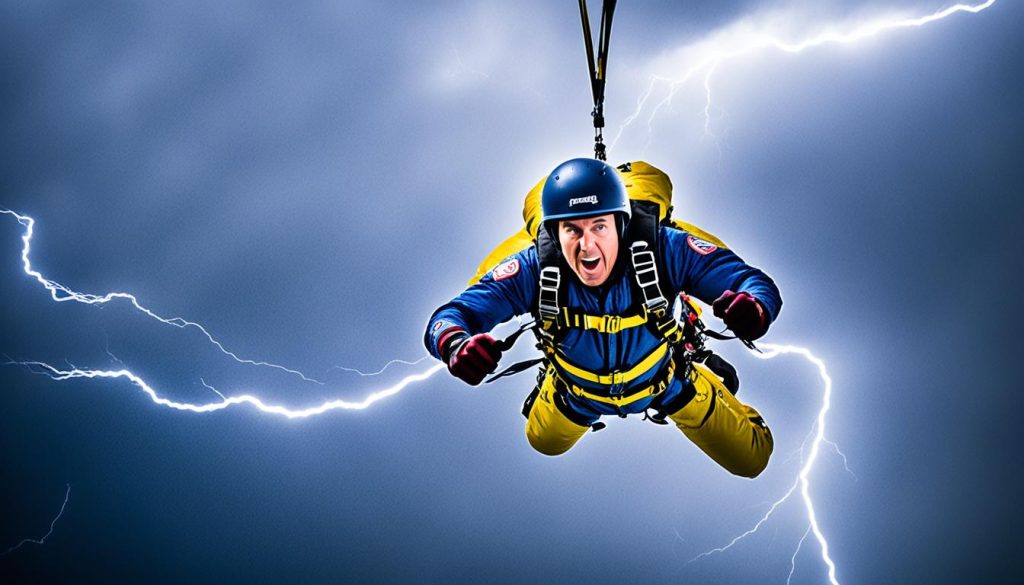
Knowing Your Limits and Making Informed Decisions
One of the most important aspects of preparedness in parachuting is recognizing and respecting personal limitations. Each skydiver has different levels of experience, proficiency, and physical abilities, and it is essential to acknowledge these factors when planning jumps.
“Being aware of one’s limitations is crucial in preventing accidents. It’s always better to err on the side of caution and prioritize safety over unnecessary risks.”
– James Smith, Professional Skydiver
By honestly assessing one’s abilities and limitations, skydivers can make informed decisions about the type of jumps they are comfortable with and choose the appropriate level of challenge for their skillset. This self-awareness plays a vital role in maintaining safety and preventing accidents.
The Role of Training and Continuous Education
Professional training and continuous education are essential components of preparedness in parachuting. It is crucial to undergo comprehensive training programs provided by recognized and reputable skydiving institutions before attempting solo jumps. This ensures that skydivers are equipped with the necessary knowledge, skills, and understanding of safety protocols.
Continuous education through regular refresher courses and advanced training programs is equally important. By staying updated on best practices, emerging safety techniques, and new equipment developments, skydivers can further enhance their preparedness and risk management capabilities.
Parachuting Safety Checklist
| Aspect | Checklist Items |
|---|---|
| Personal readiness | Physical fitness, mental preparedness, and sufficient sleep |
| Equipment checks | Thorough inspection of parachute, harness, and other gear |
| Weather assessment | Evaluation of wind speed, visibility, and other atmospheric conditions |
| Emergency procedures | Regular practice and familiarity with emergency protocols |
| Communication | Clear understanding of hand signals and communication protocols |
| Jump planning | Thorough evaluation of jump location, flight path, and landing area |
By following the above safety checklist and incorporating these practices into their routine, skydivers can significantly enhance their preparedness and risk management abilities.
Conclusion
Skydiving is an exhilarating sport that requires careful preparation and the ability to respond effectively to emergencies. By regularly practicing emergency procedures, familiarizing oneself with their equipment, and maintaining a mindset of preparedness, skydivers can enhance their safety and mitigate risks.
It is important to follow established protocols, listen to instructions from pilots, and react promptly during emergency situations. By prioritizing safety and being proactive in managing risks, skydivers can enjoy the thrill of the sport while minimizing potential dangers.
Additionally, investing in canopy coaching and staying informed about the latest safety protocols can further enhance a skydiver’s skills and overall safety. Parachuting emergency response, safety tips, and risk management should be at the forefront of every skydiver’s approach to the sport.
By embracing these essential aspects, skydivers can confidently navigate through any challenges that may arise, ensuring a safe and unforgettable experience in the world of parachuting.

